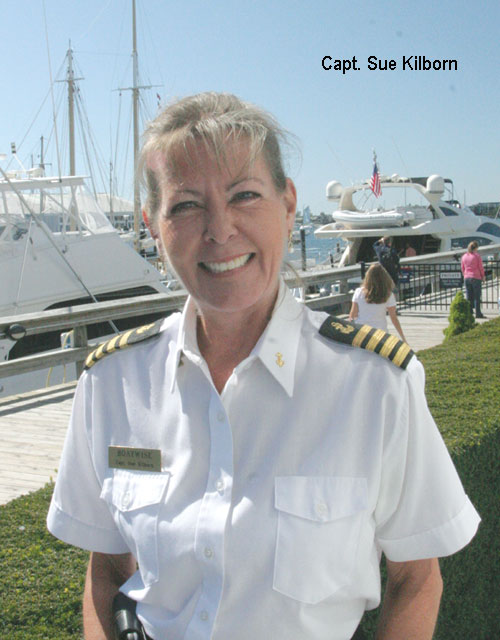Suddenly Alone
2009 December 2
What to do when the skipper falls overboard
Capt. Sue Kilborn looks out at the boat show audience and asks the unthinkable question. "What about Fred? Do you know what to do if he falls overboard or is knocked unconscious or is badly bleeding and unable to handle the boat?"
There are looks of concern and dismay among those who are the obvious first mates aboard their boats. Kilborn, who since 1990 with her husband, Rick, has run the Boatwise school for wannabe professional captains, understands all too well these feelings of inadequacy and sheer terror at the thought of being left suddenly alone.
No reason to fear, but definitely time to prepare, she says, offering basic advice on what to do if the skipper is no longer in command. Her emphasis isn't on docking and maneuvering or being able to tie a perfect bowline. It's about survival and common sense and the ability to get the boat home if the captain becomes incapacitated.
Ask yourself: Where are we? What are the sea conditions? Is help available? How do I contact them? How do I handle the boat myself?
Kilborn wryly describes recreational boating-guy at the helm, reluctant to give up control. Woman stretched out on deck, worshipping the sun, paying little heed to the boat's position, until something goes wrong.
"Like the real estate agents say, location is everything. You have to know where you are so that you can call for help and send the rescue crew in the right direction," she says.
As her informal poll shows, there are misgivings about reading the GPS and chartplotter. Confused by the electronic display, some people seeking assistance report the boat's position by reading the latitude and longitude of the CRS or cursor. Doing so tells the Coast Guard where the cursor is, not the boat, and the cursor could be wherever the last user was plotting waypoints.
Kilborn's advice: Make sure you report the vessel's position. If you don't know how to use the GPS or chartplotter, ask the skipper for a lesson before an emergency arises.
If Fred falls overboard, push the MOB button on the GPS and, if possible, stop the boat. Better still, execute a Williamson turn or do your best to head back to where Fred went over. Keep an eye on him. Remember, it's hard to spot a person in choppy waves. Toss the Life Sling. Try to approach from downwind so the boat won't run over the victim.
If Fred is still onboard but hurt, and you don't know how to operate the boat, drop the anchor, presuming the water is reasonably shallow. Before doing so, make sure the anchor line it tied off to the bow cleat, another common mistake. This will keep the boat from drifting in the current. You might have to deploy a drogue anchor if the water is very deep, the parachute-like device that will slow the boat. Help can then come to you.
When calling for help, choose the VHF radio over the cell phone.
"Cell phones are a direct line, while the radio is more like one of the old telephone party lines where you probably had 10 people listening in," says Kilborn, explaining that a VHF radio hail might be picked up by another boat much closer than the nearest rescue vessel. This point becomes very important if the boat is on fire or sinking. In that case, get off upwind so that the boat doesn't come down on you.
"If there is a fire extinguisher on board, you should know how to use it," she says.
Nearby boats can also relay a mayday to the Coast Guard. After all, the average marine radio range, depending on its antenna height off the water, is less than 12 miles and not much good to boaters offshore. An SSB radio would be far better, but many coastal cruising boats don't have one.
Coastal mariners should also note that dialing *CG on your cell phone no longer summons the Coast Guard. The system just didn't work.
If help is near, shoot off a flare. Orion flares, typically packaged in an orange plastic cylinder, are common among coastal cruisers. More powerful-and visible-SOLAS flares are often found on offshore boats. In either case, learn beforehand how to shoot them. If the flare is held directly overhead, falling fuel particles can cause burns.
If help doesn't arrive and you need to haul anchor but find it's stuck, and you don't know how to use the windlass, cut the line. "Anchors are cheap and can be easily replaced. Fred can't. So keep a sharp knife handy," says Kilborn, who recommends author Suzanne Giesemann's book, It's Your Boat Too: A Woman's Guide to Greater Enjoyment on the Water.
As for weather, pay attention to wave height and sequence. A wave every 30 seconds is typically a gentle swell, while one every four to five seconds will make the boat bounce. Cloud formations are also telling. Learn the difference among cirrus, cumulus and cumulus-nimbus clouds and what they forecast. Listen to the weather broadcast on the VHF radio by pushing the WX button.
Additional advice: Ask about magnetic compass deviation. File a float plan with somebody who cares when and if you get back. Learn as much as possible about how to handle the boat. Finally, says Kilborn, "If your partner yells at you, find another person to practice with."

Comments